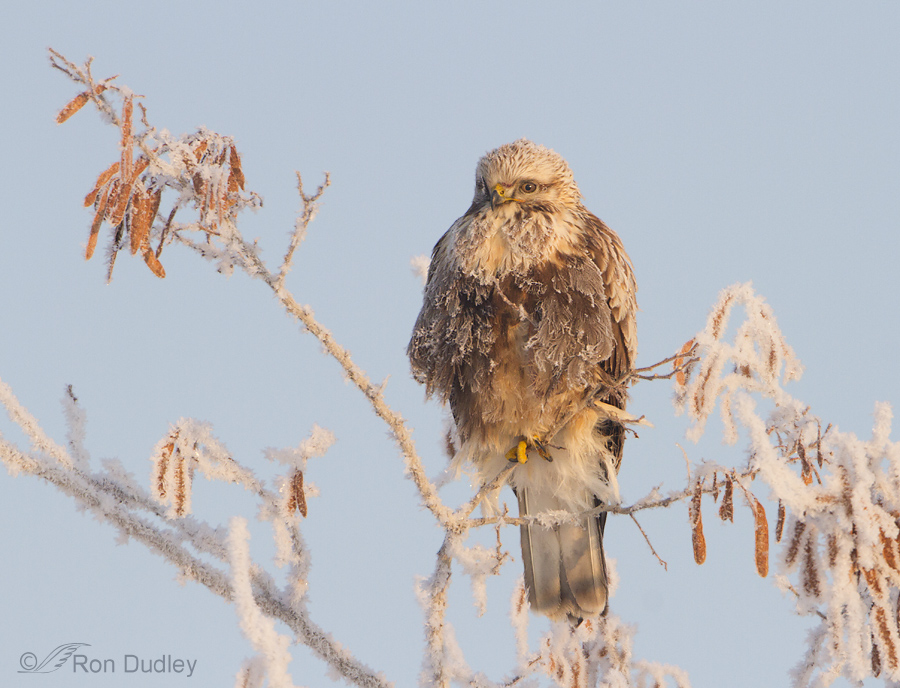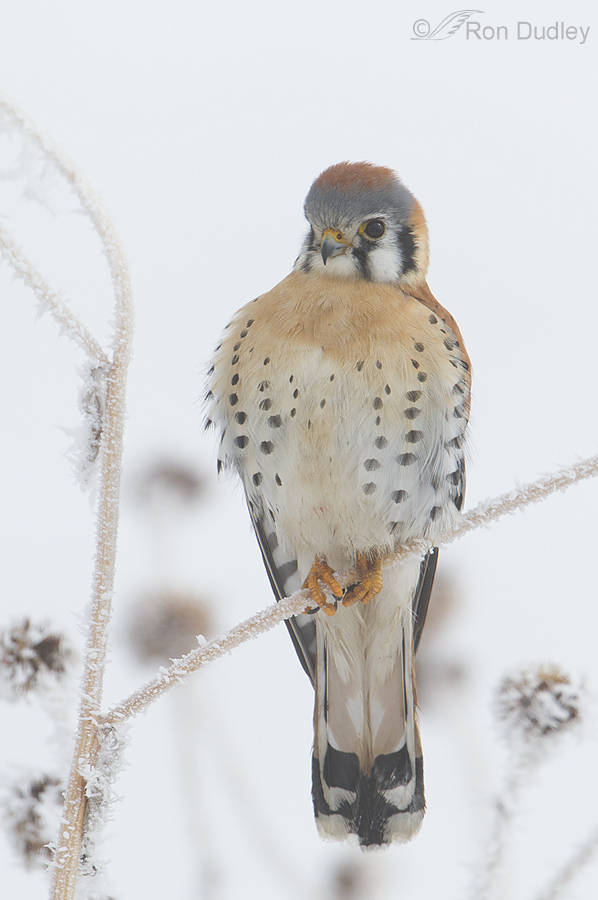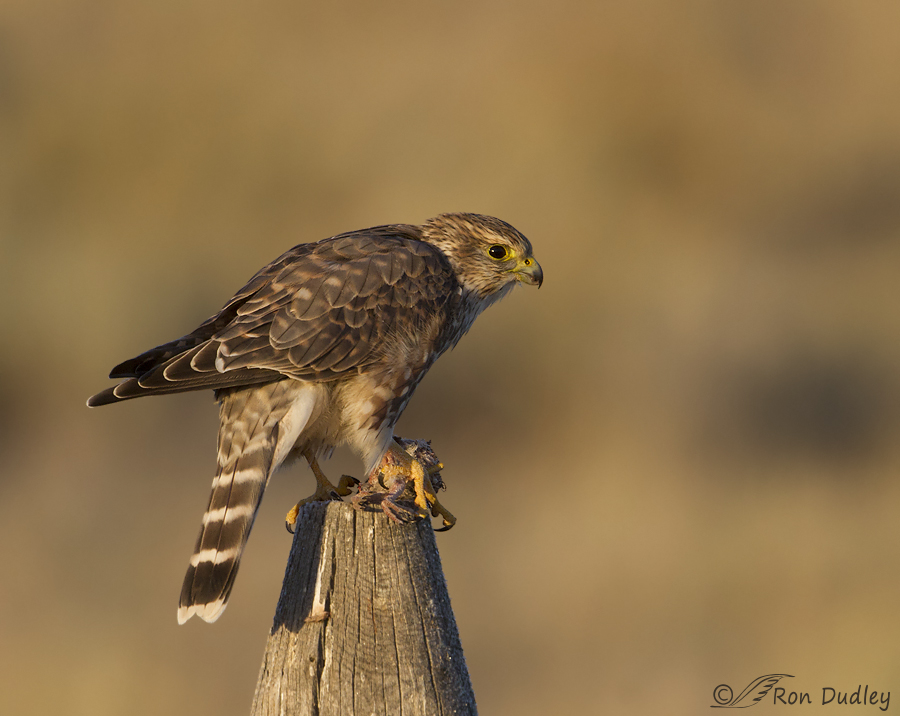Tag: fog
Rough-legged Hawk In A Frosty Wonderland

During winter, photography in the valley of the Great Salt Lake can be difficult at best due to frequent inversions that trap fog and smog in the low-lying areas and that especially includes the marshes near the lake. These inversions often last for days or even weeks and the fog and smog get progressively worse each day. But the fortunate result for photographers is the thick hoarfrost that blankets everything in the vicinity of the lake if and when the fog burns off during the day.
American Kestrel In Fog

Images of birds in fog often have a unique mood and “feel”. The tendency of many photographers is to attempt to minimize the effects of the fog during processing but I try to resist that temptation and let the image sink or swim on its true merits.
Fog tends to reduce detail and color saturation and causes the subject to appear slightly overexposed. It also often results in high key backgrounds. Some of those effects can be reduced by increasing contrast/saturation during processing but then you are losing the mood provided by the fog in the first place. All I’ve done with this image is crop and sharpen.
Winter Barn Owls In Flight
Normally it’s very difficult to find Barn Owls hunting in daylight but an extremely cold winter a few years ago caused some of them around here to continue hunting into mid-morning. They were looking for voles in the wetlands and it was fascinating to watch and photograph them as they effortlessly cruised over the phragmites and grasses, occasionally turning abruptly and diving for prey. 1/2000, f/8, ISO 400, 500 f/4, 1.4 tc, natural light, not baited, set up or called in It was very cold and frosty with lots of moisture in the air which turned the sky background a color that appeals to me. 1/2000, f/8, ISO 400, 500 f/4, 1.4 tc, natural light, not baited, set up or called in Sometimes they were low enough to get the Phragmites in the setting. Phragmites is a scourge to wetland managers but I’ve always liked it for backgrounds. When the owls would fly west I would often get light on the entire bird. 1/2000, f/8, ISO 400, 500 f/4, 1.4 tc, natural light, not baited, set up or called in But when they flew east they were sidelit. I like both effects. 1/3200, f/8, ISO 400, 500 f/4, 1.4 tc, natural light, not baited, set up or called in Partly because of their deeply set eyes it’s a challenge to get catch lights in Barn Owls. But here the bird was hovering over prey and looking down at it so because of the behavior you wouldn’t expect to get…
American Kestrels In Snow, Frost And Fog
Photographing American Kestrels near the Great Salt Lake during the coldest parts of winter is a two-edged sword. On the one hand the frigid temperatures in December and January make the kestrels “stickier” – much less likely to fly off before you can get close enough for quality photos. But there’s a down side too. Moisture from the lake often forms fog or at least makes the air so incredibly laden with moisture that good lighting often becomes an issue. I’ll still take the shot under some of those conditions though – a close-up with the bird large enough to very nearly fill the frame is still usually much more desirable than a well-lit bird so small in the frame that little detail can be seen. 2000, f/7.1, ISO 400, 500 f/4, 1.4 tc In this image the background is snow and there had been a blizzard the day before which had stacked snow up on one side of the perch. This was one of the first times I’d ever been close enough to a kestrel to get a frame-filling image and I well remember having a case of “buck fever” while photographing him at such close range. Also a bit unusual was the fact that I was actually looking slightly down at him – something that doesn’t happen often with kestrels. 1600, f/7.1, ISO 500, 500 f/4, 1.4 tc This shot illustrates well what you get when the atmosphere is so laden with moisture when it’s very cold – fog, low but even light, some reduction in detail and sometimes…
Short-eared Owl in the Fog
My friend Mia and I had such a great time in June with the Short-eared Owls at Red Rock Lakes National Wildlife Refuge in Montana that we decided to return in September. Getting close to them was more difficult this time because they weren’t nesting and feeding young. However, one morning we got lucky. A cooperative Short-eared Owl When we awoke we were socked in with heavy fog. As it slowly began to clear we went looking for birds and found this owl perched in the middle of the road. As we approached, it flew a short distance to this post and then allowed us to get very close. We’re sure this is the same female that we had photographed in June on the same territory. Short-eared Owl female looking for voles She was very accepting of our presence and within a few minutes was looking for voles below her post perch. We were right at the edge of the fog and as it would swirl around us, alternately getting thicker and then clearing a bit, we knew that some of our images would show the effect of the fog more than others. The soft feathers of owls don’t give up their fine detail to photographers easily, even in the best of conditions. But we simply couldn’t pass up this opportunity with this beautiful female and we still got some shots we like very much. Short-eared Owl checking us out Occasionally her attention would be diverted from the potential prey in the…


